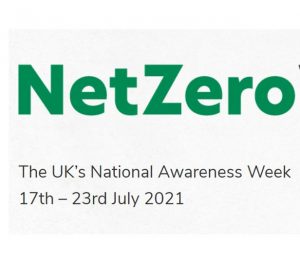What is Net Zero Week and Why is it Important?
Net Zero Week is The UK’s National Awareness Week of stopping climate change, held from the 17th – 23rd July 2021.
We all need to radically reduce our carbon emissions to combat the effects of climate change. Reaching net zero will require many new measures, innovative solutions, aggressive government policies and plenty of human effort both at work and at home. Net Zero Week is part of this much needed momentum. The UK’s national awareness week highlights the challenge and provides the best expert advice and information to help us all better understand the challenge and how to benefit from making changes.
Net zero is the world’s answer to stopping climate change. On the 27th June 2019, the UK became the first major economy in the world to pass laws to end our contribution to climate change. The legislation committed the nations of the UK to reduce all greenhouse gas emissions to net zero by 2050. Net zero means any remaining emissions would be offset by schemes to remove an equivalent amount of greenhouse gases. The EU and many other nations have now agreed to do the same, meaning net zero has been adopted as the best strategy to protect us and the natural world from rising global temperatures.
What can be done to reduce Carbon Emissions during Net Zero week?
The main aim of Net Zero Week requires us all to take on our fair share of tackling emissions to stop global warming. Boris Johnson has published The Ten Point Plan for a Green Industrial Revolution which will help the UK to become a net zero society. Every person, home and business has an important role to play. 33% of emissions are consumer based from our homes and cars. Whether you are a homeowner, rent accommodation, run a business or even a school – we are all connected in everything we do and we can all contribute and gain the many benefits.
How can Gas Sensing play a part in the Reduction of Harmful Emissions?
Gas Sensors can play a huge part in the reduction of greenhouse emissions as they often play a vital role in the monitoring and reduction of harmful activities. At Edinburgh Sensors, we produce bespoke gas sensing technology which can be used across a wide range of applications, many of which can be used to mitigate harmful gas emissions. This article presents just three of these applications; the monitoring of greenhouse gas emissions, the monitoring of methane using an infrared sensor and the detection of gases using a UAV drone.
- Monitoring of Greenhouse Gas emissions: https://edinburghsensors.com/news-and-events/measuring-greenhouse-gas-emissions/
Edinburgh Sensors Gascard NG provides high quality, accurate and reliable measurements of CO, CO2 and CH4. To find out how we can assist you with the measurement of greenhouse gas emissions, simply contact us.
- Using an Infrared Sensor for reliable Methane monitoring: https://edinburghsensors.com/news-and-events/infrared-sensor-gas-monitoring/
Edinburgh Sensors’ Gascard NG is used for methane detection in a range of research, industrial, and environmental applications including pollution monitoring, agricultural research, chemical processes and many more.
- Using a UAV drone attached to a gas sensor to measure harmful gases: https://edinburghsensors.com/news-and-events/uav-drone-methane-monitoring/
From monitoring global warming to tracking the spread of pollution, there are many reasons to use a drone in order to monitor carbon dioxide, methane and other hydrocarbon gas concentrations in remote or dangerous locations.
What Gas Sensors does Edinburgh Sensors have to offer for Environmental Protection?
One of the most sensitive approaches for the detection of environmentally harmful gases such as carbon dioxide and methane is the use of infra-red spectroscopy. Both gases absorb infra-red radiation very strongly and have unique absorption patterns or spectral fingerprints that can be used for their subsequent identification. Infra-red detection can be used for both qualitative and quantitative identification and therefore can be used to detect very low concentrations of such gases or small changes in their concentration.
Edinburgh Sensors have over 30 years of expertise in the development of non-dispersive infra-red sensor technologies and offer a range of production options suitable for tracking greenhouse gas emissions on agricultural sites. Our products have been field-tested and are very successful at tracking methane production in a working environment.
Our Gascard NG Infrared gas sensor is the perfect solution for monitoring CO₂. The Gascard NG includes real-time temperature and atmospheric pressure correction via on-board sensors and has the flexibility to incorporate additional gas detection technologies. It has onboard true RS232 communications along with the option of TCP/IP communications protocol. Key features of this reliable gas detection system include:
- On-board barometric pressure correction in the range of 800mbar to 1150mbar
- Extensive temperature compensation
- Minimum operating voltage 7V and wide operating voltage range (7V to 30V)
- True RS232 communications for control and data logging. Optional on-board LAN support.
Find Out More
Find out more about the UK’s Net Zero Week here. If you would like to learn more about how gas sensing can be used to reduce emissions, please contact a member of our team today.
If you have enjoyed reading this article, why not join Edinburgh Sensors on social media and sign up to our infrequent newsletter to be the first to know about our latest products, research and developments.

